Motorcycle First Aid Tips
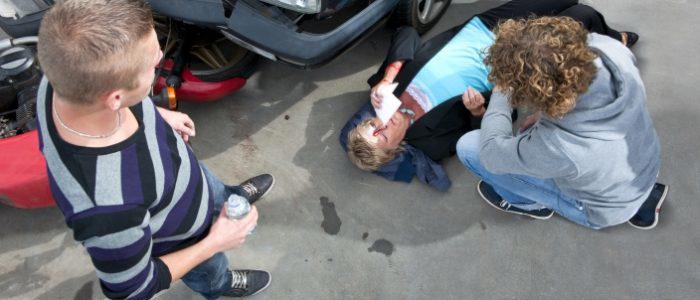
Riding a motorcycle can be as high risk as any extreme sport so it’s important every rider knows Motorcycle First Aid. The high velocity involved in riding a motorcycle can lead to life threatening injuries such as head, spinal, severe wounds, fractures, dislocations, sprains, strains and loss of consciousness.
According to the Transport Accident Commission 4% of registered vehicles in Victoria are motorcycles. However, 15% of lives lost on the road were motorcyclists or motorcycle passengers. In addition to that 17% of people hospitalised from road accidents were also motorcyclists or their passengers.
Motorcycle accidents are high impact and can cause serious damage. They require immediate First Aid assistance and its critical Motorcycle First Aid is provided correctly in those first few minutes following an accident. Follow our tips on how to provide Motorcycle First Aid to ensure you provide the right care in an emergency.
Head Injuries
A head injury can be very serious so it’s important you observe and monitor the casualty thoroughly. At times head injuries can be hard to detect, especially if you did not witness the accident. If any of the below signs and symptoms are present treat the casualty as if they have suffered a head injury.

Always follow the DRSABCD action plan.
| Conscious Casualty | Unconscious Casualty |
|
DRSABCD |
DRSABCD |
|
Help lie the casualty down in a relaxed position with their head and shoulders slightly raised
|
Move casualty into the recovery position supporting the head and neck. Open, check and clear the airway Be careful not to twist or bend the casualty’s head, neck, spine or back as they may have a spinal injury |
|
Control bleeding by applying sterile pads or dressings to the wound Do not apply pressure directly on the wound if there is evidence of a depressed fracture If any blood or fluids appear from the casualty’s ear softly position a sterile dressing to drain (lie on the side if possible to allow fluid to drain) |
Ensure the casualties airway remains open by lifting the chin if face badly injured (do not force) Watch breathing patterns
|
|
Call Triple Zero (000) for an ambulance
|
Control bleeding by applying sterile pads or dressings to the wound Do not apply pressure directly on the wound if there is no evidence of a depressed fracture If any blood or fluids appear from the casualty’s ear softly position a sterile dressing to drain (lie on the side if possible to allow fluid to drain) |
|
Call Triple Zero (000) for an ambulance |

Spinal injuries are severe and must be treated with care. It’s important that the casualty is not moved unless in danger. You must try and keep the neck and spine neutrally aligned. However, the casualty’s airway and breathing is the highest priority so if necessary to assist breathing move into the recovery position.
| Conscious Casualty | Unconscious Casualty |
|
DRSABCD |
DRSABCD |
|
Ensure the casualty is as comfortable as possible by loosening any tight clothing around the neck |
Move into recovery position cautiously Support the head and neck to keep alignment with spine |
|
Encourage the casualty not to move. Strictly do not remove the casualty unless in danger |
Ensure the casualty’s airway is clear and open |
| To prevent further damage, align the head and neck with the spine and hold in place or find other means of support |
To prevent further damage align the head and neck with the spine and hold in place or find other means of support |
|
If ambulance is not due to arrive in a timely manner apply a cervical collar if you have access to one and are trained to do so |
Call Triple Zero (000) for an ambulance If ambulance is not due to arrive in a timely manner apply a cervical collar if you have access to one and are trained to do so |
| Call Triple Zero (000) for an ambulance |
Removing a Casualty’s Motorcycle Helmet
In the case of a motorcycle accident, the casualty is likely to be wearing a helmet. Helmets should never be removed unless deemed completely necessary and performed by two people. Do NOT remove the helmet if there is only one person or they are not confident to do so correctly.
When a casualty is wearing a helmet it’s important to confirm their airway is clear. If they are wearing a half-face helmet or full-face helmet with a chin piece that lifts up, the helmet can remain on the casualty. However, the chin strap must be detached or cut to ensure the casualty can breathe comfortably.
If a casualty is wearing a helmet you must:
- Be very cautious of potential head, neck and spinal injuries. Position them on their side whilst providing support to the head and neck. Avoid any twisting during movement to avoid causing any additional damage.
- If two people are available, one person should support the head and neck, whilst the other should remove the chin strap
- One person must hold the helmet in position whilst cautiously tipping the helmet back, passing over the chin
- Then cautiously tip the helmet forward, passing over the back of the head
- Repeat and continue this process to completely remove the helmet from the casualty’s head
- Be mindful of the casualty’s ears and nose as the helmet could catch these areas and cause damage
- Position the helmet directly next to the casualty and provide to ambulance personnel upon arrival
Fractures and Dislocations
Signs and symptoms include:
- pain at or near the site of injury
- difficult or impossible to move normally
- loss of strength in area, deformity or abnormal mobility
- tenderness, swelling, discolouration and bruising
Fractures, dislocations, sprains and strains can be difficult to distinguish for First Aiders. If you are unsure always treat as a fracture.
| Fractures | Dislocations |
|
DRSABCD |
DRSABCD |
|
If there is bleeding, control and cover. Avoid applying pressure directly on the fracture site. |
Under NO circumstances should you try and reduce or reset the dislocation |
|
Check if there are any other fractures caused
|
If it is a limb injury: 1. Check for circulation in affected area. If there is no circulation softly reposition the limb to try and restore circulation 2. Call Triple Zero (000) for an ambulance 3. Support the limb with bandaging and padded products 4. Directly position icepacks over the area |
|
Ask the casualty not to move
|
If it is a shoulder injury: 1. Position the arm in the least painful position for the casualty. 2. Apply ice compress |
|
Immobilise the fracture by applying wide bandages at the joints above and below the fracture. 1. Carefully wrap bandages around the body part to provide support 2. Position a padded splint along the injury 3. Position padding between the splint to fill any gaps and prevent any movement 4. If it is a leg fracture you must restrict movement of the foot and ankle 5. In 15 minutes intervals you must confirm the bandages are not too tight or too loosely applied |
If it is a wrist injury: 1. Support the wrist in a sling 2. Apply ice compress
|
|
Monitor circulation in the foot and hand to ensure the bandages are not too tight |
|
|
Handle casualty with care |
|
|
Keep a constant watch on the casualty |
|
|
Seek medical assistance |

Sprains and Strains
| Signs and Symptoms | |
| Sprains | Strains |
|
Intense pain |
Sharp, sudden pain in the region of the injury |
|
Restricted joint movement |
Sharp, sudden pain on any movement of the muscle |
|
Joint swelling |
Loss of power to the affected limb |
|
Rapid bruising |
Tender muscle |
When providing First Aid for sprains and strains:
- Follow DRSABCD
- Follow R.I.C.E. Management plan below
- Seek medical advice

Motorcycling is a popular form of transport and hobby for many Victorians. Unfortunately, motorcyclists are at risk of serious injuries if an accident occurs.
It is important that every motorcyclist takes the appropriate precautionary steps before getting on their bike. Appropriate helmets, protective clothing and durable footwear should always be worn. However, sometimes accidents occur and First Aid is required. By following the Motorcycle First Aid Tips you will be fully prepared in the case of an emergency.
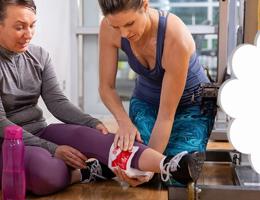
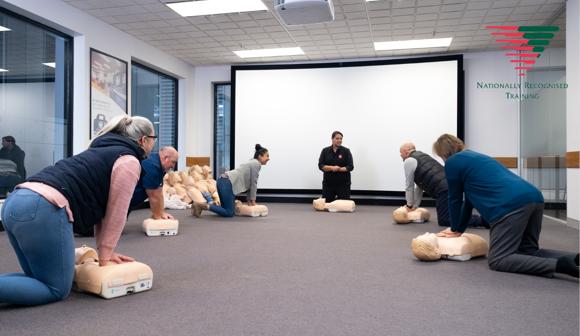
PROVIDE FIRST AID
Learn how to manage a range of common first aid scenarios.
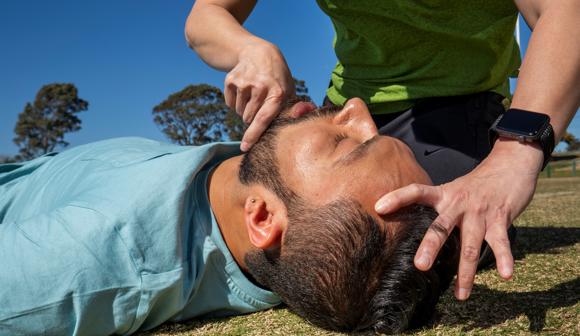
PROVIDE FIRST AID IN REMOTE SITUATIONS
Learn how to provide First Aid in remote areas where access to medical aid is difficult or delayed, including alpine, desert, marine, rural and tropical environments.
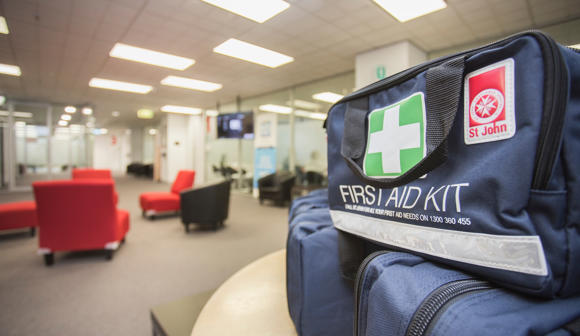
DO YOU HAVE THE RIGHT FIRST AID KIT FOR YOUR HOME, SCHOOL OR WORKPLACE?
St John has a range of First Aid products to suit any situation.
